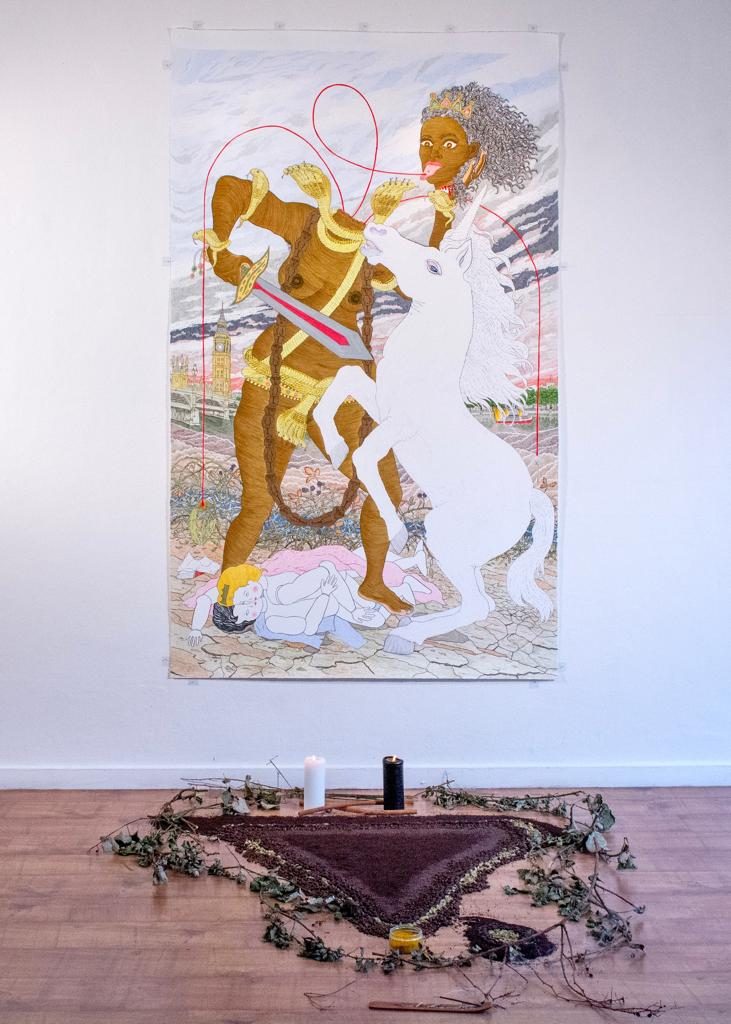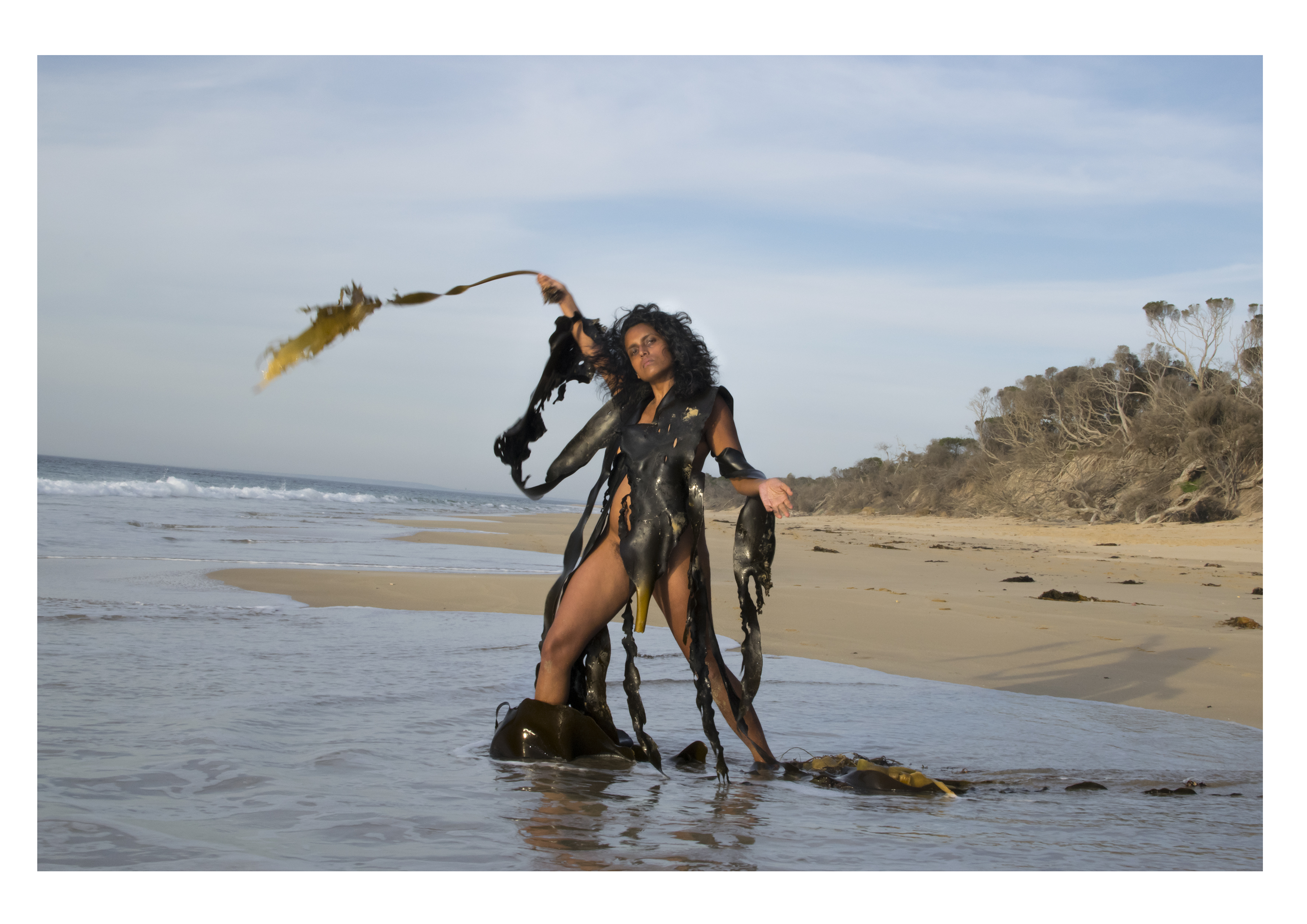
I first met TextaQueen at an event held during their exhibition, ‘The Empire’s New Clothes’ at 198 Gallery in Brixton in Spring this year. Surrounded by their monumental marker pen drawings I was struck by the work’s power along with the rich insights Texta shared about processing, and purging hate and oppression through their work as well as their ambitions to create sustainable contexts for theirs and others’ work. The following interview was conducted by email and in person as Texta sketched me for their forthcoming ‘Bollywouldn’t’ poster series collaborating with queer and trans people of the south Asian diaspora portraying storylines of decolonial resistance.
Shama Khanna: How does your residency in the UK compare to your experience in other colonised lands? By which I’m referring to your recent residency in India and in Australia where you were born?
TextaQueen: In many ways I feel more “okay“ to be here in the UK than in so-called Australia or in India – because when you ‘go back to where your colonisers came from’ it feels alright to take up space in the conversation about colonialism. I feel like my body and my work have a valued place here. In so-called Australia a lot of my work has been contemplating being a neo-colonial presence there but wouldn’t I rather be decolonialisng or seeking retribution here? I literally draw this out in my work of that name.
In India at the residency in Varanasi, I was processing so many dynamics of connection / disconnection and privilege, as well as the neo-colonial nightmare dynamics of the residency itself. And being another person taking ‘inspiration’ back to the West, making work that I’m not sure what its place would be in the place that inspired it. The series I created made so much sense when I showed it here, seemingly even more than in so-called Australia. There are so many more south Asians I’ve connected with whose lives are on tangents to mine here in London than back ‘home’. I’ve felt part of a cluster of brown and black artists working with care and integrity here, and have made more intergenerational connections. My parents migrated, and I was born, not long after the White Australia policies ended, there aren’t elder second generation POC migrants and I have very few peers my age at my intersections.

SK: I’m amazed by how productive you are: ‘The Empire’s New Clothes’ series you presented at 198 Gallery earlier this year was developed after your stay in Varanasi together with the monumentally scaled new piece ‘Retribution’ which was made here. Can you tell us about ‘Bollywouldn’t’, the series you’ve begun to cast, and sketch for in London?
TQ: There are many things that have attracted me to Bollywood including the spectacle, but obviously there are so many tropes and -isms in the genre that many of us find alienating. I’m using the format of the Bollywood movie poster especially the 60s and 70s aesthetic and have asked south Asian people who disrupt the cisheteropatriarchy to collaboratively come up with concepts for their portraits. I asked for ‘decolonial narratives’, fictionalised representations of their identity or experiences. They’ve been beautiful processes of collaboration and I’m excited to go back ‘home’ and work on these: To retell Suhag Raat (ritual of consummating marriage) as a tale of self love and masturbation or turning the criminal Gunda into Trans-Gunda.
SK: You’ve spoken about making anti-colonial work in institutions which uphold, unconsciously or not, colonial values. Is it possible not to have your work neo-colonised by the art world?
TQ: I don’t think it’s possible in the institutional art world, to not have that world reframe your work to fit their colonial narrative, but it’s still a site where people who need and understand decolonial work are going to experience it. I have had important experiences with people’s work in those contexts, just with an unsettling awareness that it’s despite the context – rolling through a lot of sticky white mud, knowing the context is probably diluting the rad intention. I value most the experiences with art and artists outside of the institution or commercial space, seeing people in their processes especially. It’s just hard for most people to make and fund work and support themselves outside. I’m planning to launch a space in so-called Melbourne in the near future, hoping to balance ties in the art world with sustainability out of it.

SK: How do the vernacular materials (‘Texta’ markers and paper) you use in your practice register in the white white cube?
TQ: For a long time I’ve talked about the accessible medium in the less accessible context being a disruptive or subversive thing. I know I began using it for its literal accessibility when analogue photography and video years ago were very expensive and digital versions non-existent. I’ve definitely had guardians of white cubes use the childhood medium (as well as my caricatured style and my brown femme body) to paternalise my work and myself. But there’s nothing like someone who doesn’t ‘usually like art’ in/or gallery spaces nor often see themselves and their experience on white walls, more comfortably engage with my work because of the medium.
SK: How has the feedback you’ve received in these contexts impacted your practice?
TQ: I don’t know if I describe it as feedback as much as backlash? And for sure that feeds back into my practice – I’m making work that processes the intersections I experience (into their broader contexts), I then show the work where the same dynamics are activated onto the work and myself, which I then process again creatively. It’s a hall of mirrors! I’ve been trying to figure out how to draw this in my ‘Circus of the Oppressed’ series, which is inspired by my experiences having a survey show at a large institution and the flaming hoops of fire many are expected to jump through with a smile and handshake.
A decolonial practice for me is, during the creative process, letting go of imagining the white liberal audience reaction to the work and keeping present in mind myself and an audience who will feel empowerment through the work.
SK: I wonder, as your career has evolved, have your values impacted the opportunities open to you?
TQ: I’ve definitely abandoned access and opportunities that felt compromising. I’m also certain that the way it works is that you’re not always aware of what opportunities are not offered to you because you previously didn’t smile and be polite in the face of people and places expressing values that harm you. But I’ve had a lot of opportunity to connect with people I respect who are living and making art with care and integrity and they must be connecting with me because they see similar values in me. This time in London has restored my faith that I’m making wise choices to live in emotionally and creatively sustainable ways. I feel I’m in a really lucky position, and have decent financial cushions, to be able to balance making work in ways that sustain myself and others with a minimum of polite smiling or explaining to people who don’t understand experiences outside their own. We’ll see how this all translates into ‘career’ over the long haul, but I try focus now on making the work I want and need to do, with gratitude for the resources that I have.
SK: The photographic documentation of your work almost looks printed, it’s so neatly executed. Can you talk about your relationship to digital technology? Your main medium drawing is very physically demanding, would you ever consider using an iPad to make your work?
TQ: I never want to forget or leave entirely the pleasure of drawing pen to paper from life (not photographs) – it’s a different part of your soul that’s activated when drawing vs using digital technology. I do use computers as a tool for research and design, like in my poster series, I’ll be doing digital mock ups from scanned drawings and digital collage that I’ll then redraw the final composition. I feel very attached to the marker medium. It’s very physically intense and time consuming and impacts my body pain but I doubt working more on a computer would be any healthier.
SK: I really appreciate your insights into your process and the precision of your words but how much do you feel you have to be the first voice to talk about your work?
TQ: Well, part of the motivation of The Story of Eve was to have others be the voice, wanting multiple interpretations by other femmes of colour articulating across genres. Unsurprisingly there’s a lack of appropriate critical reviews of my work by the Australian art world. It’s hard to find a critic who prioritises, understands or experiences the intersection of things I’m making work about. But there’s many people witnessing my work who don’t need me to voice it to understand it. The art world often makes me feel like I have to defend the sensuality and empowered sexuality that are part of my decolonial intentions. I’ve experienced my work ‘prompting’ racist misogynistic emotional violence and physical boundary crossing towards myself including by other femmes and women, white and brown, that’s clearly linked to the world’s lack of value for brown femme bodies and the threat felt when those bodies choose to depict ourselves in empowerment.
TextaQueen is a multi-genre artist of Goan descent living on unceded Wurundjeri land. Known for using the humble felt-tip marker to create majestic portraiture, their work complicates assumptions around identities at the intersections of gender, race, sexuality, and ability. Their practice envisions an ever-expanding alternate universe of collective and transformative possibility, centring those not often witnessed in states of empowerment.
Encompassing drawing, painting, printmaking, video, performance, curating, music, writing, and murals- in collaboration with other displaced and diasporic people- they deliver irreverent satire in enticing colour and detail that disrupts all the “isms” entrenched in the status quo. Texta contemplates dis/connection to cultural and colonial legacies, interrogating the many ways in which they find themselves precariously balanced across ancestral and stolen lands
TextaQueen’s work has appeared at the Gallery of Modern Art, Brisbane; Museum of Contemporary Art, Sydney; Western Exhibitions, Chicago; 198 Contemporary Arts and Learning, London; and Kunsthalle Darmstadt, Germany, and is held in the collections of the National Gallery of Victoria, University of Queensland, Heide Museum of Modern Art, Monash University of Modern Art, Art Gallery of Western Australia and the National Portrait Gallery of Australia. Mural commissions include de Young Museum, San Francisco; Murray Art Museum Albury; City of Moreland; and City of Melbourne. They have undertaken residencies at ACME, London; International Studio and Curatorial Program, New York; and Queensland Art Gallery. A mid-career survey exhibition toured nationally via Mornington Peninsula Regional Gallery in 2017.
TextaQueen is currently developing TheySwarm, a peer-mentorship artist residency for diverse and disabled artists, in their Johnston Street, Collingwood studio on Wurundjeri land.
Image credits:
Homepage: Texta Queen, ‘Flame within the Frame’ 2018 shown as part of the live art event ‘Circus of the Oppressed’ organised by Texta Queen at Space, London in July 2019 featuring performances by Jacob V Joyce, Travis Alabanza, Lasana Shabazz and Krishna Istha.
Texta Queen, documentation from the making of the ‘Bollywouldn’t’ series 2019
This page: Texta Queen, ‘Sacred Landscape’ from the ‘Gods Save the Queen’ series presented at 198 Gallery, London in May 2019
TextaQueen, ‘Retribution’ installed at 198 Gallery with shrine by Raju Rage and Daniella Valz Gen
Texta Queen, The Empire’s New Clothes, 2017
Texta Queen, ‘Summoner’ from the Eve of Incarnation series 2016
